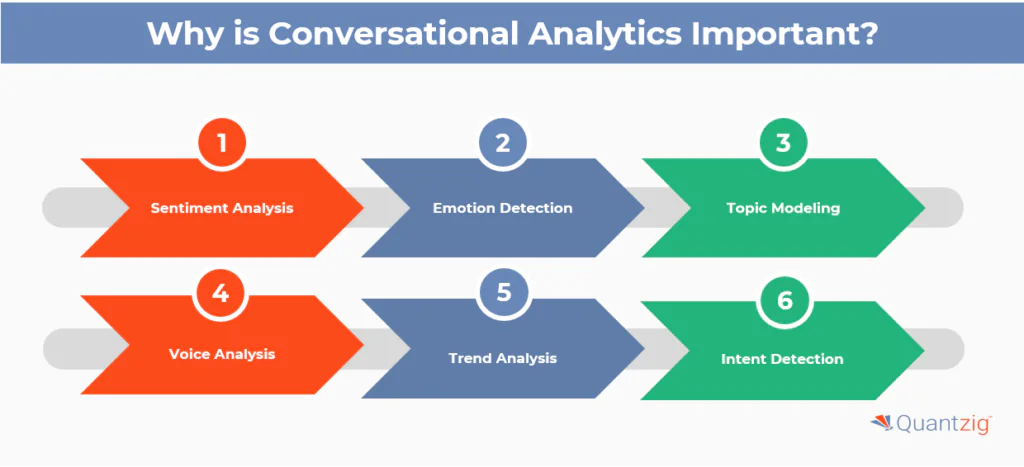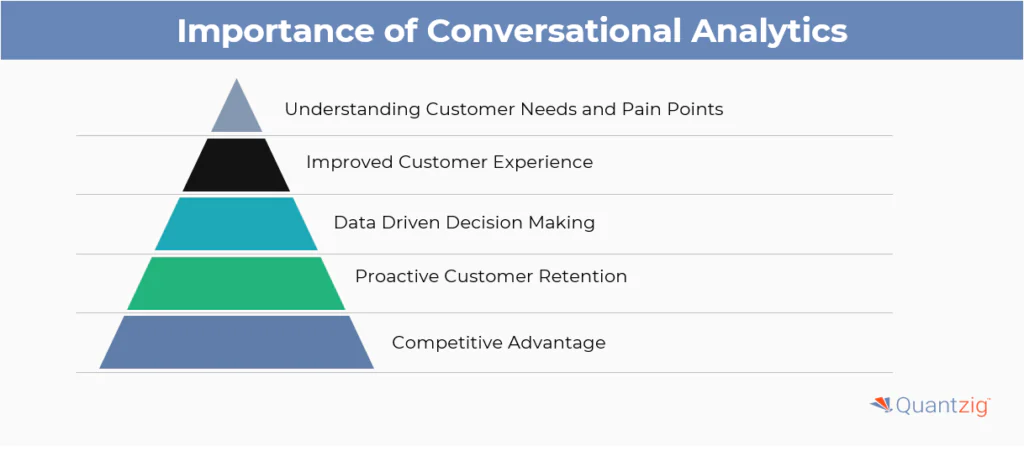Written by: Medha Banerjee
Table of Contents
Introduction on Conversational Analytics
As we are expanding in the business world, engaging with the audience in order to cater to their particular demands has become crucial. However, correct implementation of conversational analytics is the most effective method to collect unsolicited feedback about any business that you require. This approach helps you to interpret and analyze your customers’ intentions, emotions, and actions.
As an expert, Quantzig has successfully catered to a similar problem for one of their clients and this article will deep dive into the case study to help you understand how the implementation goes.
Book a demo to experience the meaningful insights we derive from data through our analytical tools and platform capabilities. Schedule a demo today!
Request a Free DemoHow Quantzig Enhanced Consumer Insights and Decision-Making Using Their Conversational Analytics Solutions
| Category | Details |
|---|---|
| Client Details | US CPG Multinational with centralized budgeting and decentralized execution for digital and non-digital channels. |
| Challenges | Existing social media listening platform provided broad, non-actionable insights at the consumer segment level, inaccurate sentiment analysis, and outdated feedback summarization and key themes detection. |
| Solutions Offered | Unified customer conversational analytics solution using AI and ML. Provided a holistic view of consumer feedback, in-depth sentiment analysis, comparison across platforms, and enhanced emotion detection model to extract 15+ emotions. Analyzed promotional and organic posts for actionable insights. |
| Impact Delivered | Provided valuable insights on key sentiments, emotions, and consumer feedback. Aided customer service teams in better resolution and prioritization of service. Helped understand if promotional messages were delivered. Auto-segregated complaints and prioritized them based on severity and dissatisfaction. |
Challenges Faced by the Client
Client is a CPG Multinational with centralized budgeting and decentralized execution for digital and non-digital channels. Client was using a social media listening platform for consumer insights which wasn’t giving actionable insights at consumer segment level and most of the insights were similar and very broad to make any decisions. The Sentiment analysis was not accurate and the feedback summarization and key themes detection was also outdated and ineffective.
How Quantzig Incorporated Conversational Analytics Solutions for Impactful Result?
Quantzig built a unified customer conversational analytics solution using conversational AI and ML implementation. It helped in providing a holistic view of consumer feedback, themes of discussions going on in social media around their products, more in-depth sentiment analysis, and comparison across social media platforms with an enhanced emotion detection model to extract 15+ emotions from user comments and posts. The emotion detection was a unique feature and it helped in reducing disparity across social platforms in terms of available reactions. Promotional posts and organic posts were analyzed using the Customer COnversational Analytics Pipeline to provide actionable insights for improved decision making by marketing teams and service teams.
Impact Delivered using Quantzig’s Expert Solutions
Making use of the expert team’s input, Quantzig took help of advanced tools like Gen AI Libraries, Python and AWS Services and Tableau to drive an impactful result based on the problem that the Client had initially come up with. Some of the impactful deliveries that was achieved as a result of the collaboration are:
- The social media intelligence tool helped to provide valuable insights to the business around key sentiments, emotions, and consumer feedback.
- It helped in providing inputs to customer service teams for better resolution and prioritization of service.
- The key themes of discussion helped in understanding if the intended message of the promotion was delivered or not.
- The complaint segregation pipeline further helped in the auto-segregation of complaints and prioritized them based on severity and level of dissatisfaction shown by the customer in their feedback.
Experience the advantages firsthand by testing a customized complimentary pilot designed to address your specific requirements. Pilot studies are non-committal in nature.
Request a free trial nowWhat is conversational analytics: An Overview
In order to understand the impact needed by the customer, we have to first dive into the meaning of Conversational analytics. In short, it is the process of analysing and extracting meaningful insights from conversational data, for example, customer interactions via social media, AI chatbots solutions, customer service calls, emails, and other forms of communication. This analysis makes use of natural language processing (NLP), machine learning (ML), and artificial intelligence (AI) to understand and interpret human language in a way that provides actionable insights for businesses.
What importance does Conversational Analytics hold for businesses?
However, there are some key aspects of conversational analytics within the AI and Advanced Analytics solutions. These include:

- Sentiment Analysis: It included identifying and categorizing emotions and opinions expressed within conversations.
- Emotion Detection: This helps in recognizing a range of emotions like happiness, anger, or sadness that in conveyed in text or speech.
- Topic Modeling: Comprises of identifying and categorizing topics that are discussed in conversations to understand the main points of interest or concern.
- Voice Analysis: This helps in analyzing spoken interactions to detect vocal characteristics that help in providing additional context.
- Trend Analysis: As suggested by the name, it helps in identifying trends and patterns in conversations over a certain time to provide information about various business strategies.
- Intent Detection: True to its name, it helps in understanding the objective behind customer queries and comments to improve response accuracy and relevance.
Conversational analytics helps businesses enhance customer experience, improve service delivery, and make informed strategic decisions by leveraging the rich data embedded in customer communications.
Unlocking Business Potential with Conversational Analytics
Conversational analytics is crucial for businesses because it unlocks a treasure trove of insights hidden within customer interactions. Here’s why it’s important:
Understanding Customer Needs and Pain Points
By analysing conversations, businesses can identify what customers are saying and what problems they’re facing. This allows them to tailor products, services, and support to better meet customer needs.
Improved Customer Experience
Conversational analytics helps pinpoint areas where customer interactions are clunky or frustrating. Businesses can use this knowledge to improve customer service processes and overall experience.
Data-Driven Decision-Making
Conversations with customers are a rich source of data. Conversational analytics helps extract meaningful insights from these interactions, empowering businesses to make data-driven decisions about marketing, product development, and more.
Proactive Customer Retention
By analysing conversations, businesses can identify customers who might be at risk of churning. This allows them to take proactive steps to retain these valuable customers.
Competitive Advantage
In today’s data-driven world, understanding customer sentiment is key to staying ahead. Conversational analytics equips businesses with the insights they need to gain a competitive advantage.
Building a Conversational Analytics Solution: Key Challenges
While the benefits of conversational analytics are substantial, building a robust solution involves several key challenges:
Complex Natural Language Processing (NLP)
Developing systems that accurately understand and interpret various languages, dialects, slang, idioms, and context is highly complex.
Data Integration Challenges
Integrating conversational data from multiple sources and ensuring it harmonizes with existing data infrastructure can be technically challenging.
Data Privacy and Security
Ensuring compliance with data privacy laws and protecting sensitive information during collection, processing, and storage is critical.
Scalability Concerns
Scaling the system to handle increasing volumes of conversational data without losing performance or accuracy is a significant challenge.
Real-Time Processing
Providing real-time or near-real-time analysis and insights from conversational data requires advanced and often resource-intensive processing capabilities.
Accuracy and Context Understanding
Achieving high accuracy in understanding the context, intent, sentiment, and nuances of conversations is difficult and requires sophisticated algorithms.
Multimodal Interactions
Handling interactions that include text, voice, and even visual inputs adds complexity to the system.
User Experience and Adoption
Designing an intuitive and effective user interface that encourages adoption and regular use among end-users can be challenging.
Continuous Learning and Adaptation
Continuously updating the system to learn from new data and adapt to evolving language use and business needs demands ongoing effort and resources.
Customization and Flexibility
Ensuring the solution can be customized to meet specific business requirements while maintaining the flexibility to adapt to future changes.
Quality of Training Data
Access to high-quality, labelled training data is essential for training accurate models, but obtaining and curating this data can be challenging.
Get started with your complimentary trial today and delve into our platform without any obligations. Explore our wide range of customized, consumption-driven analytical solutions services built across the analytical maturity levels.
Start your free trial nowKey Benefits of Conversational Analytics for Businesses
Despite the challenges, the benefits of implementing conversational analytics are compelling:
Enhanced Customer Understanding
Analyse customer interactions across various channels to gain a deeper understanding of their needs, preferences, and pain points. This allows for more targeted marketing, improved product development, and personalized customer experiences.
Improved Customer Satisfaction
Identify areas for improvement within customer service interactions by pinpointing common frustrations and inefficiencies. This data can be used to streamline processes, provide better agent training, and ultimately boost customer satisfaction.
Data-Driven Decision Making
Extract valuable insights from customer conversations to inform strategic business decisions. Conversational analytics can provide metrics on customer sentiment, product feedback, and marketing campaign effectiveness, empowering data-driven approaches across the organization.
Reduced Customer Churn
Proactively identify customers at risk of churn by analysing conversations for signs of dissatisfaction. Early intervention allows businesses to address customer concerns and implement retention strategies.
Competitive Advantage
Gain valuable insights into customer sentiment and market trends compared to competitors. Conversational analytics equips businesses with the knowledge to tailor offerings, optimize marketing campaigns, and stay ahead of the curve.
Conversational analytics is transforming the way businesses interact with customers by analyzing natural language conversations. This technology, powered by artificial intelligence (AI), enables companies to gain valuable insights from interactions occurring through chatbots, virtual assistants, and automated messaging platforms. By integrating conversational analytics with customer relationship management (CRM) systems, businesses can enhance their understanding of customer needs and preferences. Through advanced sentiment analysis, companies can gauge customer emotions and attitudes, leading to more personalized and effective communication strategies. The process involves the collection and pre-processing of conversational data to ensure accurate and actionable insights, ultimately improving customer engagement and satisfaction.
The Future of Conversational Analytics
Conversational analytics is set to revolutionize how businesses interact with their customers and make strategic decisions. As technology continues to advance, conversational analytics modules has the ability to become more sophisticated, incorporating enhanced social intelligence and social media intelligence capabilities. These advancements will propel businesses to gain deeper market intelligence and a much more detailed consumer insights generation. By leveraging automated feedback segregation, companies can efficiently categorize and prioritize customer feedback, ensuring that critical issues are addressed promptly. This, in turn, will lead to significant improvements in customer service, as businesses can respond to customer needs more effectively and efficiently.
Natural language conversations pushed by chatbots, virtual assistants, and automated messaging platforms will be an important part to these improvements. Enhanced collection and pre-processing of data will empower customer relationship management (CRM) systems with advanced sentiment analysis powered by artificial intelligence (AI). This will enable businesses to better understand and respond to the emotions and needs of their customers, ultimately fostering stronger customer relationships and driving business success.
One of the key components driving the future of conversational analytics is the emotion extraction module, which allows companies to understand and analyze the emotions behind customer interactions. Leveraging natural language processing (NLP) or NLP techniques, businesses can enhance their conversation analytics capabilities to gain deeper insights into customer interactions. Conversation analysis and reporting tools enable detailed examination of dialogues, facilitating improved customer support by identifying key issues and trends. Voice of the customer (VoC) analysis captures customer sentiments and feedback, providing valuable data for sales and marketing optimization and strategic planning.
Conclusion
Additionally, customer journey mapping and customer journey analysis offer a comprehensive view of the customer experience, highlighting touchpoints and areas for improvement. This holistic approach not only enhances the overall customer experience but also supports risk management by identifying potential issues before they escalate. By integrating these advanced NLP techniques, businesses can ensure a more effective and responsive approach to customer engagement.
In conclusion, while the path to implementing conversational analytics comes with its set of challenges, the rewards in terms of enhanced customer understanding, improved satisfaction, data-driven decision-making, reduced churn, and competitive advantage make it a worthwhile investment for forward-thinking businesses.





